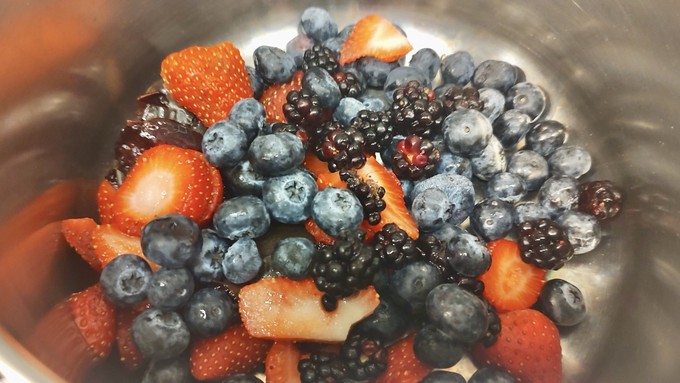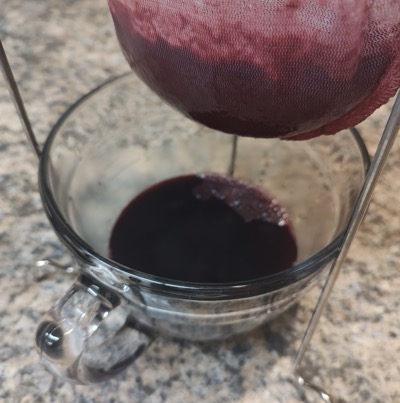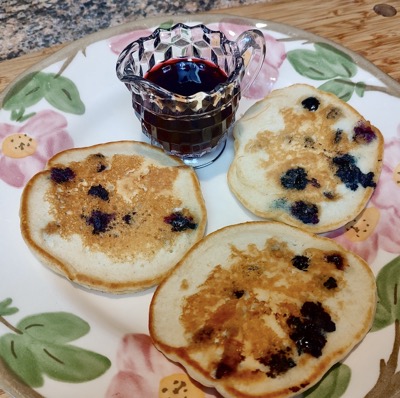
Recipe: Very berry syrup mixes strawberries, blueberries, blackberries and more

A mix of berries, plus a few other random summer fruits, go into the fruit syrup. Debbie Arrington
Late summer fruit can seem like a collection of leftovers – the last of the berries (but not enough to make jam) and (often overripe) plums, pluots or peaches. What to do with these odds and ends past their prime?

Mix them together into a fruity syrup that’s a sure hit on pancakes, French toast or other breakfast favorites. (Debbie's sour cream blueberry pancake recipe can be found here. ) It’s wonderful drizzled over vanilla ice cream or plain cheesecake, too.
Berries tend to dominate this syrup’s profile in both flavor and color – that’s why it’s “Very Berry” and not just “miscellaneous mixed fruit.” For this batch, I used equal amounts of strawberries and blueberries plus the last of our wild blackberries and two overripe pluots. Like blending wine varietals, that mix of fruit creates a syrup that’s deep in flavor as well as color.
Very berry syrup
Makes about 2 cups
Ingredients:
2 cups mixed berries and/or fruit (blueberries, strawberries, blackberries, plums, pluots, peaches, etc.)
1 lemon or lime
1 cup water plus more if needed
1-1/2 cups sugar

Instructions:
Prepare fruit. Hull strawberries and roughly chop. Remove pits from stone fruit if using.
In a heavy 2-quart saucepot, place prepared fruit. Squeeze juice of lemon or lime over fruit; gently toss. Add 1 cup water. Over medium-high heat, bring to boil, then reduce heat. Simmer fruit until very soft, about 20 to 30 minutes.
Strain the juice using a jelly bag, fine sieve or two layers of cheesecloth. Measure juice; it will be about 1-1/2 cups. (Add a little water if needed.)
Return juice to saucepan. Add sugar, stir to dissolve. Bring mixture to boil. Boil for 2 minutes, stirring often.
Remove from heat and let cool slightly. Transfer to jar or bottle. Store covered tightly in refrigerator.
Comments
0 comments have been posted.Sacramento Digs Gardening to your inbox.
Food in My Back Yard Series
May 6: Maintain soil moisture with mulch for garden success
April 29: What's (already) wrong with my tomato plants?
April 22: Should you stock up on fertilizer? (Yes!)
April 15: Grow culinary herbs in containers
April 8: When to plant summer vegetables
April 1: Don't be fooled by these garden myths
March 25: Fertilizer tips: How to 'feed' your vegetables for healthy growth
March 18: Time to give vegetable seedlings some more space
March 11: Ways to win the fight against weeds
March 4: Potatoes from the garden
Feb. 25: Plant a fruit tree now -- for later
Feb. 18: How to squeeze more food into less space
Feb. 11: When to plant? Consider staggering your transplants
Feb. 4: Starting in seed starting
Sites We Like
Garden Checklist for week of May 11
Make the most of the lower temperatures early in the week. We’ll be back in the 80s by Thursday.
* Plant, plant, plant! It’s prime planting season in the Sacramento area. Time to set out those tomato transplants along with peppers and eggplants. Pinch off any flowers on new transplants to make them concentrate on establishing roots instead of setting premature fruit.
* Direct-seed melons, cucumbers, summer squash, corn, radishes, pumpkins and annual herbs such as basil.
* Harvest cabbage, lettuce, peas and green onions.
* In the flower garden, direct-seed sunflowers, cosmos, salvia, zinnias, marigolds, celosia and asters. (You also can transplant seedlings for many of the same flowers.)
* Plant dahlia tubers.
* Transplant petunias, marigolds and perennial flowers such as astilbe, columbine, coneflowers, coreopsis, dahlias, rudbeckia and verbena.
* Keep an eye out for slugs, snails, earwigs and aphids that want to dine on tender new growth.
* Feed summer bloomers with a balanced fertilizer.
* For continued bloom, cut off spent flowers on roses as well as other flowering plants.
* Add mulch to the garden to maintain moisture. Mulch also cuts down on weeds. But don’t let it mound around the stems or trunks of trees or shrubs. Leave about a 6-inch-to-1-foot circle to avoid crown rot or other problems.
* Remember to weed! Pull those nasties before they set seed.
* Water early in the day and keep seedlings evenly moist.